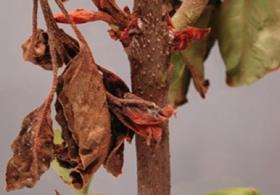
The number of confirmed kiwifruit canker cases in New Zealand has risen over the weekend to 11, and while an official plan has not yet been released, industry figures are increasingly speculating that containment may be the most likely outcome.
As of midday Monday, infections of the Pseudomonas syringae pv actinidiae (Psa) kiwifruit canker have been confirmed in 11 orchards in the Te Puke region, with a further three under the same ‘restricted place notice’ quarantine conditions.
Testing outside that original zone of infection has so far turned up no positive detections, giving hope to the New Zealand kiwifruit industry that plans for containment or potentially even eradication may be realistic.
New Zealand’s biosecurity officials are expected to announce an attack plan either this evening or tomorrow New Zealand time, according to local media reports, as more results of testing come in.
“I’m becoming clearer in my mind where the picture is – it’s looking to me that it’s localised, certainly in the Bay of Plenty. But maybe more information will come through tonight which scuppers that. I think a lot of in-formation will be through by tonight,” said Kiwifruit Growers Incorporated president Peter Ombler last night before a high-level industry meeting, reported Business Day.
He said if the infection did turn out to be limited to the Te Puke region, the likelihood was that Psa was a recent arrival, rather than a dormant resident brought on by the cold winter as happened in Italy this year.
But adding urgency to any eventual plan us the announcement by Zespri yesterday that advanced symptoms had been spotted in the orchard with the first confirmed infection, with vines weeping red sap and shoots and canes dying.
Those symptoms are similar to those shown in Italy’s Lazio region this year, where a strain of the Psa bacteria has killed up to 50 per cent of vines in some orchards.
“If there’s anything to be learned from Italy it’s that there’s no time for hesitation, discussion and argument,” Doug Voss, an organic kiwifruit grower and the former chairman of Zespri, told the Bay of Plenty Times. “Infected plant material needs to be removed at once and disposed of in a controlled and efficient manner.”
Affected growers have begun cutting out infected vines and removing them under the supervision of the New Zealand Ministry of Agriculture and Forestry (MAF), and copper spraying to limit the spread of Psa is also progressing.






No comments yet